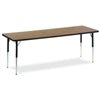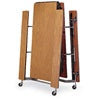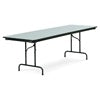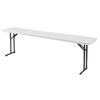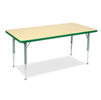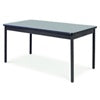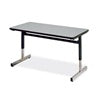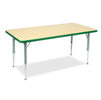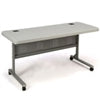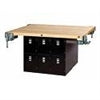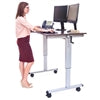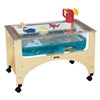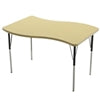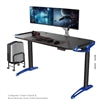School Tables
In the modern educational landscape, classrooms are evolving from traditional, teacher-centric spaces into dynamic environments that promote active learning and collaboration. At the heart of this transformation are classroom tables, which play a pivotal role in creating conducive learning settings. In this article, we delve into the significance of classroom tables in today’s educational landscape and explore the features that make them essential tools for educators.
The Ever Changing Classroom
Collaborative Learning
One of the significant shifts in education is the move toward collaborative learning. Traditional rows of desks have given way to flexible arrangements that facilitate group work, discussions, and peer-to-peer interaction. Classroom tables lie at the core of this change, serving as platforms for student collaboration.
Multifunctional Spaces
Modern classrooms are multifunctional spaces that cater to a variety of teaching styles and activities. Classroom tables are designed to adapt to these diverse needs, providing educators with the flexibility to rearrange the furniture to suit the task at hand.
Features That Foster Learning
When considering classroom tables for educational settings, several features prove to be instrumental:
Adjustable Heights
Classroom tables with adjustable heights cater to students of varying ages and sizes. This feature ensures that tables can be configured to accommodate both elementary school students and high schoolers comfortably.
Durability
The rigors of daily classroom use necessitate durability. Choose tables constructed from high-quality materials that can withstand the demands of an active educational environment. Sturdy tables are more likely to endure the test of time.
Mobility
Mobility is key in creating adaptable learning spaces. Tables equipped with casters or wheels can be easily moved and reconfigured, allowing educators to transform the classroom to align with their teaching goals.
Integration of Technology
Incorporating technology into education is now the norm. Look for classroom tables with built-in technology integration, such as power outlets and cable management solutions. These features simplify the use of devices like laptops and tablets during lessons.
Maximizing Classroom Tables in Education
Flexible Arrangements
Experiment with various seating arrangements to maximize the potential of classroom tables. Create clusters for group activities, circles for discussions, or traditional rows for lectures. The adaptability of these tables empowers educators to tailor the classroom setup to suit their teaching objectives.
Active Learning Stations
Designate specific areas within the classroom as active learning stations, complete with tables, chairs, and collaborative tools. Encourage students to use these stations for problem-solving, brainstorming, and group projects.
Technology-Centric Spaces
For technology-driven lessons, reconfigure the classroom to create technology-centric spaces. Position tables in a way that facilitates the use of interactive whiteboards or other tech tools, enabling engaging and interactive teaching.
Table Shapes and Sizes
The shape and size of classroom tables should align with both the physical space and the educational objectives. Rectangular tables are common and highly versatile, suitable for both individual work and collaborative projects. Circular or horseshoe-shaped tables, on the other hand, are excellent for fostering group discussions and collaborative work. For classrooms with limited space, trapezoidal or semi-circular tables can be effectively used to maximize room usability.
When choosing tables, it’s also essential to consider how they can be combined or moved around to support different teaching methods and learning activities. Flexibility in classroom furniture supports a dynamic learning environment where the setup can be quickly altered to suit the lesson plan, thereby enhancing student engagement and participation.
In summary, the right classroom tables are those that fit well within the physical space, accommodate the age and activities of the students, and offer flexibility to adapt to various teaching styles. By carefully selecting tables based on these criteria, you can significantly impact the effectiveness of the educational experience.
Classroom Tables for Different Educational Levels
Preschool and Elementary
For the youngest learners in preschool and elementary settings, classroom tables must prioritize safety and adaptability. Features such as rounded corners, lightweight design, and adjustable heights are essential to prevent injuries and accommodate the rapid growth of young children. Additionally, tables at this level often incorporate bright colors and engaging shapes to stimulate learning and creativity. It’s also crucial that these tables are easy to clean, as younger students tend to engage in messier activities such as painting and clay modeling. Ensuring that the tables can be adjusted is a great way to make the furniture grow with the students, making it a cost-effective choice for educational institutions.
Middle and High School
As students progress to middle and high school, the functionality and durability of classroom tables become even more important. At these educational levels, students engage in a wider variety of subjects requiring specialized tables. For instance, science labs need tables that are resistant to chemicals and heat, while technology classes may require tables with integrated power sources and data ports. In these settings, tables often need to support heavier books, technology devices, and lab equipment. The design should also encourage good posture and ergonomics to support longer periods of study, reflecting an increased focus on comfort to aid concentration and learning retention.
Classroom tables are the linchpin of modern education, enabling collaborative and dynamic learning experiences. Their adaptability, durability, and functionality empower educators to create engaging environments that cater to diverse teaching methods and student needs. As we continue to innovate in education, the role of classroom tables in shaping the learning landscape remains pivotal, ensuring that students are prepared for the challenges of the 21st century.
Quality Classroom Furnishings from School Outlet
Choosing the right classroom tables for your school is a crucial decision that significantly impacts the learning environment and student interaction. It’s essential to select tables that are not only functional and durable but also contribute to a positive and engaging educational atmosphere. At School Outlet, we understand these needs and are committed to providing high-quality classroom solutions that meet them.
Our range includes various styles, from traditional fixed tables to folding tables and versatile activity tables. Each product is designed with the understanding that classroom furniture plays a vital role in facilitating effective learning. Our classroom tables are built to withstand the rigors of daily academic activities, are easy to maintain, and have aesthetic qualities that enhance your school’s educational setting.



